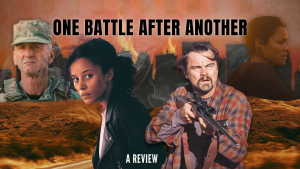A professor’s hardest lesson
April 26, 2007
Outside the window of the Lucile Packard Children’s Hospital in Palo Alto, people are walking around, enjoying the day and shopping. There are young children clinging to the arms of their mothers as they walk into local department stores.
Sacramento State communication studies professor Pam Sanger sits next to the window, between a food tray and a hospital bed. She looks outside. “I probably look like them,” she said. “But I’m here for such a different reason.”
Sanger’s 4-year-old son, Patrick James, is in the hospital bed next to her, watching a Batman movie and hugging a stuffed yellow cat. Hooked up to Patrick is a tube of clear liquid, silently pumping medication through a port in his chest. Patrick has a disease called Langerhans Cell Histiocytosis, or LCH.
“The disease, in which white blood cells overproduce and form lesions/tumors which attack the organs that they are in, could spread throughout many parts of his body,” Sanger wrote on www.caringbridge.org/visit/pjs, a website dedicated to Patrick.
LCH is not a cancer, but is defined as being a cancer-like condition, affecting certain blood cells called histiocytes, and is often treated with chemotherapy. The disease first affected Patrick’s skin as a newborn, leaving irritations under his arms, groin and abdomen. The Sanger family was told by doctors that the irritations were due to Patrick’s skin not being dried after a bath. But after battling with the “irritations” with no improvement, the Sangers sought help elsewhere. By this time, Patrick had gotten worse.
“They thought he was at the end stage of his disease. He had no skin left. Basically, it was only flesh. Plus, he was almost deaf. We were horrified.”
The cause of LCH is unknown, and there is no known prevention. It only affects about one in 250,000 children and one in 1 million adults in the United States every year.
After two rounds of aggressive chemotherapy treatment, Patrick went into what is called a “no-active disease” stage. A year later, on March 6, 2007, the Sanger family brought Patrick to the hospital when he complained of having pain in his head. “He said: ‘My head hurts right here,’ and he pointed,” Sanger said. X-rays showed the disease had spread to his skull.
“Suddenly, we found ourselves in this world where kids get really, really sick and kids can die. It’s not something that you can ever be prepared for,” Sanger wrote in an e-mail. “When you have a child, you rarely think: ‘This baby could die.'”
Because of the close proximity to the brain, the tumors are putting Patrick at great risk of central nervous system damage. “The histiocytes have eaten away large parts of his skull…at the forehead, in the orbit, across the bridge of his nose and in a bone that is deep inside the skull, supporting the eye socket,” Sanger said.
Immediately, the doctors scheduled six more rounds of chemo. After two, they will conduct a CT scan. “If (the tumors have) gotten bigger or there are more holes, then this isn’t working,” Sanger said.
If that’s the case, the next step in chemo would be 24-hour hospitalization, with highly-toxic, more intensive chemotherapy. Repetitive chemotherapy is hard on the body because it kills off some harmless cells along with the tumors. “It’s like if you punch someone. They keep getting up, but they’ll get up slower and slower each time,” Sanger said.
“The medicine kills some good cells and all the bad cells,” Patrick said.
“Just some of the bad cells, right?” Sanger asked.
“No! All the bad cells,” Patrick said. “Or else I get more medicine.”
Despite what Patrick has been through, he is still a typical 4-year-old, clinging to his stuffed kitty and giggling hysterically at the word “butt.”
Having been in and out of the hospital for the majority of his life, Patrick has become friends with the nurses and doctors.
“They dote on him and they love him,” Sanger said.
He does not, however, enjoy the hospital food.
“It tastes yucky because the medicine makes food taste yucky,” Patrick said. Often, chemotherapy can add a medicine-like or metallic taste to foods because the cells on the tongue are affected.
It’s the medical tape that Patrick fears most. Never mind the needle that gets jammed into his chest in order to start chemo every 21 days, it’s taking the tape off his skin that upsets Patrick.
“It’s really sticky and they have to pull it off his chest,” Sanger said.
For Sanger, the disruption to everything that is normal is the worst part. “It’s like, in the space of 24 hours, you have to change everything.”
Sanger had to take Patrick out of preschool because his immune system couldn’t handle the germs other children carry.
“You think everything’s fine?but you just never know,” she said.
As for teaching at Sac State, Sanger said: “Sac State has been really good to me. The department, HR, students in my classes ?” In fact, many of the guests on the website are students.
Sanger is a part of the Catastrophic Leave Donation Program at Sac State, according to Communication Studies Department Chair Nick Burnett.
“In her case ? after her sick leave or vacation time is exhausted, other people can donate their vacation time to her, so she can still get paid,” Burnett said.
However, the program can only work if faculty members are willing to donate their vacation time.
“She needs donations,” said Joanne Davis, Disability Leaves Manager in the Human Resources Department. “It’s a very helpful thing because medical bills are very high,” Sanger said.
She added that she’d rather see a cure for the disease than get paid. To donate to help find a cure for LCH, visit hikeforacure.com. Lauren King can be reached at [email protected]





















































































































